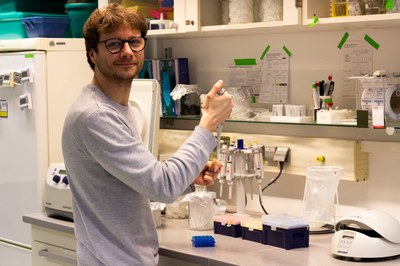Johannes Oppermann
|
|
Room: 003 Email: johannes.oppermann@hu-berlin.de Tel: (030) 2093 98279 |
Channelrhodopsins (ChRs) are light-gated ion channels mediating phototactic responsesin motile algae and widely used as optogenetic tools to manipulate cellular activity usinglight. Many cation- and anion-conducting ChRs (CCRs and ACRs) have been identifiedfrom culturable chlorophyte and cryptophyte species. However, most microbial organismscannot be cultured, resulting in an incomplete view of the diversity of ChRs. My interest lies in the identification and characterization of new and interesting ChRs from marine environments. The identification of new ChRs offers the potential to increase our understanding of ChRs and to acquire new optogenetic tools. Therefore, we teamed up with the lab of Oded Béjà at the Technion – Israel Institute of Technology, applying bioinformatics on metagenomic and transcriptomic databases. Recently, we described the MerMAIDs as well as a group of viral and prasinophyte ACRs.
Publications
Rozenberg, A.*, J. Oppermann*, J. Wietek, R. G. Fernandez Lahore, R.-A. Sandaa, G.Bratbak, P. Hegemann, and O. Béjà (2020). Lateral gene transfer of anion-conductingchannelrhodopsins between green algae and giant viruses. Current Biology 30, 1-11.doi: 10.1016/j.cub.2020.09.056
*These authors contributed equally
Oppermann, J., P. Fischer, A. Silapetere, B. Liepe, S. Rodriguez-Rozada, J. Flores-Uribe, E. Peter, A. Keidel, J. Vierock, J. Kaufmann, M. Broser, M. Luck, F. Bartl, P. Hildebrandt, J. Simon Wiegert, O. Béjà, P. Hegemann, and J. Wietek (2019). MerMAIDs: A Family of Metagenomically Discovered Marine Anion-Conducting and Intensely Desensitizing Channelrhodopsins. Nature Communications 10, 1, 3315. doi: 10.1038/s41467-019-11322-6
Marques-Carvalho, M.J.,J.Oppermann, E. Muñoz, A.S. Fernandes, G. Gabant, M. Cadene, S.H. Heinemann, R. Schönherr, and J.H. Morais-Cabral (2016). Molecular Insights into the Mechanism of Calmodulin Inhibition of the EAG1 Potassium Channel. Structure 24, 1742–1754. doi: 10.1016/j.str.2016.07.020
